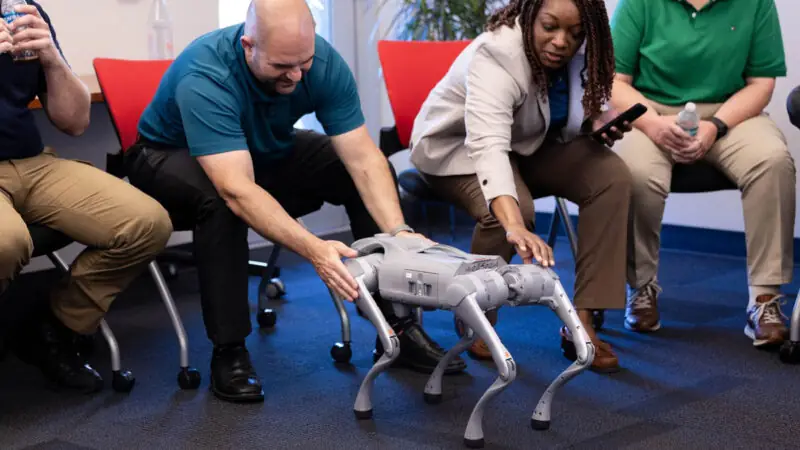National Public Safety Innovation Academy participants get first-hand look at cutting-edge technology

At the National Public Safety Innovation Academy (NIA), curriculum changes with trends and technology. During the eight-week executive level course, participants get the opportunity to see the latest advances up close and to work with them hands-on thanks to the strong partnership between the Polk County Sheriff’s Office and Polk State College, and the vision of Sheriff Grady Judd.
Since the inception of NIA in September 2022, participants have gotten a firsthand look at new-age GPS pursuit technology, rapid DNA testing, virtual reality training, non-lethal de-escalation technology, drug and explosive detection mobile scanners, robotics and drones – aerial and underwater. Earlier this month, Class 5 participants had the chance to operate the intelligent bionic quadruped robot – or robot dog – designed by Stokes Robotics.
“This program brings technology to the forefront,” said Lt. Craig Blessing of the Harford County Sheriff’s Office in Maryland. “We don’t just talk about it here. We see how it works and operate it ourselves.”
Evolving technology and leaders
A partnership between Polk State College and the Polk County Sheriff’s Office, NIA is a STEM-based program that allows law enforcement and corrections personnel to take the next step in their careers. Participants learn from subject matter experts on a variety of topics that affect the ever-changing world of public safety.
As technology modernizes in the world of public safety and corrections, the STEM-based curriculum evolves to meet the needs of communities across the country and create leaders who inspire others, transform their organizations, and deliver results.
“We bring the experts in from all around the country to speak to us and lecture us as to how we can be on the cutting edge. I wanted a program that’s next level and that’s what we have here,” Judd shared with participants when the program launched in 2023. “The new way is based in science, technology, engineering, math, communications, and relationships with your communities. You’re not only leaders of your agencies today, but you’re the leaders of tomorrow.”
The robot dog
The robot dog has several features, including obstacle avoidance and video recording. It can also be programmed to respond to voice commands.
“We can use technology to keep people safe,” noted Bill White, Vice President of Sales for Stokes Robotics. “One of the most dangerous things a police officer can do is bridge a doorway. I’d rather have a robot shot at than a person. Why not let the robot go first?”
Lt. Chris Carabajal of the Rio Rancho Police Department in New Mexico called the lessons and demonstrations in technology eye-opening.
“The focus on technology has been big and is one of the areas I admittedly lack,” he shared. “It’s been eye-opening to learn about the technology that’s available – not just through demos but through networking. To be able to network with people in this class and to discuss how they’ve implemented it in their departments has been phenomenal.”
One of just three national command schools in the U.S., NIA has had participants from more than 20 states. Among the technology-centric topics explored over the eight weeks are predictive analytics, cyber threats, artificial intelligence (AI) and futuristics.
“Technology is huge,” exclaimed Sgt. Danny Allison of the Caseyville Police Department in Illinois. “It’s crazy what can be done with AI. Criminals are using it. We have to know the potential threats.”
Ahead of the curve
The Polk County Sheriff’s Office was one of the first agencies nationwide to implement a technology called Live911. The technology allows law enforcement officers to hear 911 calls as they happen rather than wait for dispatchers to relay the information.
“We’ve had a very positive experience,” said Kim Riggall, IT manager for the Sheriff’s Office. “We’ve saved lives left and right. In cases of medical calls, we were able to save lives because we were closer than firefighters and EMTs when the call came in.”
Riggall conducted a demonstration during NIA. The Sheriff’s Office experimented with the technology in its Southeast District more than five years ago but has since implemented it department-wide. The technology comes with a built-in customizable mapping system that allows law enforcement officers to hear calls specific to their city, region, or patrol area.
“Our deputies can hear 911 calls as they happen,” Riggall added. “This is a direct, live connection. Our law enforcement officers hear it live.”
Riggall said that on average, it takes about a minute from the time the 911 call comes in for a dispatcher to relay it to law enforcement. With Live911, officers can respond as soon as the call comes in. It also allows officers and dispatchers to communicate directly.
“Technology moves very fast,” White added. “It doesn’t take very long to get behind and we know the bad guys are using it. If our law enforcement agencies aren’t staying up to speed, they’re doing a disservice to their communities.”
“Anything that was cutting edge in terms of police technology was here at NIA,” Allison concluded. “We have to stay in front of the curve and use technology to our advantage.”
The next NIA cohort begins on Sept. 2 and runs through Oct. 24. More information, including how to apply, can be found here.

